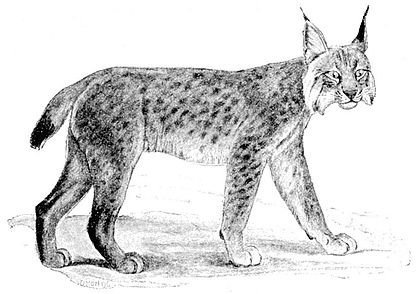The Fishing Cat, F. viverrina, of India and China, is about 3 feet 6 inches including the tail. Its black spots upon a grey-brown ground have a tendency to form longitudinal lines. It is in fact, on Eimer's theory, a case of longitudinal stripes breaking up into spots. It differs from the bulk of Cats by preying upon fish, though it is not known how it catches them. It also feeds upon the large snail Ampullaria. In addition to these there are twenty-four species of Cats found in the Old World, mainly in the Oriental region, of small to moderate size.

Fig. 196.—European Lynx. Felis lynx. × 1⁄12.
The European Lynx, F. lynx, has rather long legs, a short tail, and tufted, pointed ears. It has only two premolars in the upper jaw instead of the usual three. It seems to be doubtful whether the Asiatic Lynx can be distinguished from the European, but the Spanish form, F. pardina, does appear to be distinct. The Common Lynx, sometimes called F. canadensis, also ranges into America, where some other forms exist, known by the specific names of F. rufa and F. baileyi.
In America there are altogether sixteen species of Cats, if we allow three species of Lynx, none of which, however, does Dr. Mivart allow to be different from the European and Asiatic Lynx (F. lynx).
